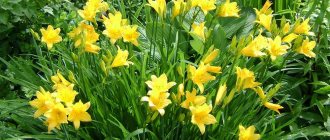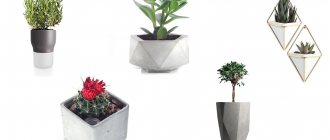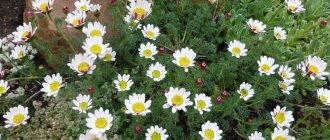Every experienced gardener knows the huge role that properly selected lighting for indoor plants plays. Along with watering and soil, light is an indispensable component on which successful growth directly depends. It is no secret that in the natural environment, some plants thrive in shaded areas, while others cannot develop without direct exposure to sunlight. At home, the situation looks similar. Let's talk in detail about how to properly make artificial lighting for indoor plants.
Decorative lighting and lighting for plant growth
A lamp for growing indoor plants is a great way to extend daylight hours. After all, many indoor flowers are of tropical origin, which means they experience a daily lack of solar energy, especially in winter. For effective plant growth, the daylight hours should be about 15 hours. Otherwise, they weaken, stop blooming and are susceptible to various diseases.
When planning the future illumination of indoor flowers, it is important not to miss the aesthetic component. The phytolight should become part of the interior, a unique decorative element. There are a huge number of lamps on sale with wall mounts of different shapes, suitable for any energy-saving lamp: CFL or LED. Depending on the size of the home flower garden, lighting can be made from several spot lights aimed directly at each green pet, or from tubular fluorescent lamps with a reflector. Using your own imagination, you can make an original LED phytolight yourself.
Main signs of insufficient lighting
With insufficient sunlight, the plant quickly begins to change its appearance. The leaves become less saturated in color, and sometimes simply begin to crumble. In some cases, it is possible that round spots may appear on the surface of the leaf plate.
The flower noticeably increases in height. The stem becomes thin and lifeless.
If one of these symptoms is detected, it is necessary to change its location on the window opening.
To quickly restore the plant, you can install an additional light source. How to decorate lighting for indoor plants? Everything is quite simple.
For this you will need:
- LED Strip Light;
- table or standing lamp designed for indoor plants.
To normalize the life processes of plants, there are special types of lamp lighting.
Tropical species require more powerful devices. As for indoor violets and orchids, a small flow of lighting is enough for them. Such devices have several modes for simulating solar radiation.
The most important component of growth is the light spectrum
In order to understand how inhomogeneous light is from different electrical sources and the sun, you need to look at their spectral composition. The spectral characteristic is the dependence of the radiation intensity on the wavelength. The solar radiation curve is continuous throughout the visible range with a decrease in the UV and IR regions. The spectrum of artificial light sources in most cases is represented by individual pulses of different amplitudes, which as a result gives the light a certain hue.
During the experiments, it was found that for successful development, plants do not use the full spectrum, but only its individual parts. The following wavelengths are considered the most vital:
- 640–660 nm – velvety red color, necessary for all adult plants for reproductive development, as well as for strengthening the root system;
- 595–610 nm – orange for flowering and fruit ripening;
- 440–445 nm – violet color for vegetative development;
- 380–400 nm – near UV range to regulate the rate of growth and formation of proteins;
- 280–315 nm – mid-UV range to increase frost resistance.
Lighting with only the listed rays is not suitable for all plants. Each representative of the flora is unique in its “wave” preferences. This means that it is impossible to fully replace the sun's energy using lamps. But artificial lighting of plants in the morning and evening hours can significantly improve their life.
Flower lighting in winter
In cold weather, the period of time for illumination is extended. In winter, the choice of lighting device is approached not only based on the required illumination, but also taking into account temperature characteristics. Some plants bloom at certain temperatures, others at completely different temperatures. Plants that love warmth can survive in winter with very low amounts of heat and light. For other colors, lighting is important. They are illuminated for 12 hours - in the morning and evening, since they receive less sunlight.
Key Features
The flower itself is of great importance in organizing lighting. You need to find all the information about him and only after that you can select what will suit him. Any flower has its own specific characteristics, which must be taken into account. The main work is to ensure that there is a lack of sunlight.
You need to know exactly the seasonal norms. This will determine the effectiveness of the light. Proper lighting will stimulate growth and it will be visible.
Lighting for orchids in winter
For orchids you need to create a special climate, since these flowers grow in exotic countries. It's warm and sunny there. The optimal illumination indicator for these colors is a level from 10,000 to 30,000 Lux. Some types of orchids may need 15,000 lux.
You should not use conventional solutions as light bulbs. It is better to buy a phytolamp. This will avoid burns to the top and bottom leaves.
The most important condition when lighting orchids is that the lamp should not get hot. Ideally, your hand will not feel any heat at a distance of 10 cm from the plant. The distance from the lamp to the flower should be between 10 and 50 cm. This depends on the power of the lamp. So, for 10 cm, a light bulb is placed in the device, producing 7000 Lux. For a distance of 10 cm you need 5200 Lux. For 50 cm you will need 1700 Lux. The backlight duration is on average 12 hours.
LED strip lighting
This option is the most optimal. The tape is easy to attach anywhere and its light is very suitable for plants. The tape is cut to size with scissors and glued to a suitable surface. The LED spectrum leads to accelerated plant growth. Take a look at the photo - this is LED lighting.
You can also glean interesting and useful data from the article. In the comments you can write how and who has organized such lighting, you can attach a photo. This will be useful to many.
How to choose a lamp for plants (2 videos)
Various lamps and lighting options (40 photos)
Signs of lack of light
There are a number of signs by which it is easy to identify a lack of light. You just need to take a close look at your flower and compare it with the standard. For example, find a similar view on the Internet. A clear lack of illumination manifests itself as follows. The plant slows down its growth. The new leaves are smaller and the stem becomes thinner. The lower leaves turn yellow. The flower either stops blooming completely, or the number of buds formed is less than the statistical average. It is assumed that watering, humidity and air temperature are normal.
LED backlight switch
What kind of LED backlight switch is there?
Divided into types:
- According to the control method.
- Installation type.
- By connection type.
Consists of parts: external part, sensor, switching circuit, surface-mounted or built-in housing. Mounting: a modular switch is attached.
Its small size makes it possible to install it on a profile. The switch is mounted next to the LED strip.
To make it, you need the ability to solder and knowledge of electrical engineering.
You will need a set of parts to assemble the switch. You need to assemble according to the diagram that can be found on the Internet.
How much light do you need?
It is impossible to give a definite answer to this question. Just as a person can live in different parts of the globe, so an indoor flower can grow on a windowsill facing north, south, west or east. Throughout its life, the plant will strive to adapt to current conditions: stretch upward due to lack of light or, conversely, expose the next blossoming bud to the sun’s rays.
By observing the appearance of the stems and leaves, the size and number of flowers, you can determine the adequacy of the lighting level. At the same time, do not forget about what stage of development the indoor flower is at: growing season, flowering, seed ripening. At each stage, it takes light from the sun of the wavelength that it needs at the moment. Therefore, when organizing additional lighting, it is important to take into account the qualitative component of the light flux.
Long-term exposure to bright light from the sun and lamps with an illumination level of more than 15 thousand lux is favored by those indoor flowers that grow in the open air in their natural habitat. These are many people's favorite crassula, geranium, kalanchoe, and begonia. Artificial lighting for plants of this type in the evening will benefit them.
Representatives of the flora that feel comfortable in illumination of 10–15 thousand lux include spathiphyllum, clivia, saintpaulia, tradescantia and dracaena. The leaves of these types of indoor flowers do not like hot sunlight, but also do not tolerate early twilight. Therefore, the ideal place for them would be a window sill with access to the west, where in the evening their leaves will receive the necessary energy from the setting sun.
So-called shade-loving plants can bloom and develop away from the window opening, being content with illumination of up to 10 thousand lux. However, this does not mean that they will die if they are placed in a brighter place. They just need less direct sunlight. These include some types of ficus and dracaena, philodendron, as well as tropical vines.
Advantages of phytolamps for plants
Advantages of the devices:
- LED bulbs consume less energy compared to incandescent bulbs.
- Operation for 50,000 hours without loss of light quality.
- The most effective way of lighting, ensuring the full development of sprouts.
- The lamp does not emit heat, that is, the plants will not overheat and burn even at a minimum distance to the device.
- Easy to use - changing light bulbs does not require special skills.
- Phytolamps are environmentally friendly devices; they do not contain substances hazardous to human health and the environment.
- Ability to adjust light saturation; no flicker.
- Non-explosive.
- The spectrum of colors does not contain ultraviolet radiation that is dangerous for sprouts.
- Thanks to complete sealing, use in rooms with high humidity is allowed.
The main point is to choose the right device and install the phytolight above the plant.
Supplementary lighting for plants and artificial lighting sources
In most cases, indoor plants need additional lighting. Flowers, which at first glance have bright green succulent leaves and bloom regularly, will look even better if they are exposed to a phytolamp. If someone thinks otherwise, then he has an excellent chance to be convinced of the error of his thinking and assemble a phyto-lamp with his own hands. To extend daylight hours, various sources of artificial light are used. Let's look at each of them and figure out which light is best for plants.
Incandescent lamps
Illuminating plants with incandescent lamps is the least effective for several reasons. The emission spectrum of conventional light bulbs with a spiral is strongly red-shifted, which does not contribute to photosynthesis in any way. Low efficiency and, as a consequence, enormous heat generation drive their energy and light efficiency to zero. In addition, incandescent lamps have the shortest service life compared to other artificial light sources.
Fluorescent lamps
Tubular fluorescent or, as they are most often called, energy-saving fluorescent lamps of the T8 full spectrum type (T = 5300–6500°K) are considered the best option for illuminating indoor plants for many years.
They have earned many positive reviews due to the presence of a selective spectrum, efficiency and low heat transfer combined with reasonable cost. Companies specializing in the production of fluorescent lamps offer plant growers an improved option - a phytolamp with a selective emission spectrum. They work predominantly in the blue and red range, as can be seen from the characteristic glow. But the cost of such lamps for illuminating plants is an order of magnitude higher than their conventional counterparts.
DNAT
A sodium lamp is the most efficient light source. In terms of luminous efficiency and working life, these lamps are comparable to LEDs for plants. But they are not suitable for home use due to their excessively high brightness (more than 15 thousand lux). But in many greenhouses and conservatories, growing plants under artificial lighting is based precisely on gas-discharge lamps. Due to the fact that they emit more red light, they are installed in combination with 6500K fluorescent lamps.
LED light sources
All LED phytolights are divided into three groups:
- bicolor;
- with multispectrum;
- with full spectrum.
Bicolor or two-color lamps are based on blue (440–450 nm) and red (640–660 nm) LEDs. Their light is considered to be the most optimal for organizing illumination of any plants during the growing season. This working spectrum favors the process of photosynthesis, which leads to accelerated growth of green mass. That is why summer residents prefer blue-red LED lamps when growing vegetable seedlings on the windowsill.
LED lamps with a multispectrum have a wider application due to the expansion of the red range into the region of infrared and yellow light. They are in demand for illuminating adult plants, stimulating flowering and fruit ripening. In apartment conditions, it is better to use LED multispectrum for flowers with a dense crown.
A phytolight with a full spectrum of radiation can be used to illuminate flowers in an apartment, regardless of the type and location. This is a kind of universal artificial light source that emits over a wide range with maximums in the red and blue zones. The full spectrum LED lamp is a tandem of energy efficiency and light energy reminiscent of the action of sunlight.
Today, the creation of favorable conditions for a widespread transition to phyto-LEDs is not happening for two reasons:
- high cost of high-quality lamps for plants;
- a large number of fakes based on conventional LEDs.
How to increase illumination
When looking for a place for a lamp, remember an important rule: illumination decreases greatly with distance. By doubling the distance between the lamp and the plant, we will give it only a quarter of the original amount of light. Lighting is most effective if the rays fall on the illuminated object perpendicular to the surface. Since the leaves of most indoor flowers are located horizontally, the source should shine as strictly from top to bottom as possible.
There is a way to significantly increase the illumination of a surface while maintaining all the parameters of the light source. Using a reflector allows you to increase light output by up to 50%. The principle of operation of this device is to reflect upward and sideways light from the lamp down to the plants. Point light sources (incandescent, energy-saving and gas-discharge lamps) are most often equipped with a conical or elliptical reflector, and fluorescent tubes are U-shaped. White matte surfaces reflect light best, not mirrors, as we used to think.
Often reflectors are provided with lamps in which a light source is installed. For halogen incandescent lamps and high-pressure discharge lamps, the reflectors may be contained in the bulb itself. You can make a simple reflector yourself from foil and tin. But remember that it must be fireproof and provide for heat removal from the lamp.
You can complete the creation of a home artificial light system using electric timers, designed in the form of an adapter: the device is plugged into an outlet, and the lamp cord is connected to it. A timer with a mechanical programmer is much cheaper than an electronic one, but is not as easy to use. The latter's microcomputer allows you to program the lamp on/off with an accuracy of up to a minute for a week or month in advance, and you can set different lighting modes on different days.
When choosing a light source, pay attention to the type and electrical power of the lamp - they determine the intensity of the glow. The color richness of the spectrum is also very important: for successful growth and flowering, plants need the red and blue components of sunlight. The human eye is adapted to perceive yellow and green rays. A bright lamp, from our point of view, may well turn out to be dim for an indoor flower or seedling.
Lighting characteristics are presented in the table below (
e)
What light is best for growth?
Of course, the ideal light source is solar energy. In apartments with windows facing southeast and southwest, you can grow any flowers, placing them in different parts of the room. But don’t be upset for those who only have a north-facing view from their window. Fluorescent and LED lamps for lighting plants compensate for the lack of sun rays.
Fluorescent lamps for plants are a time-tested budget option. They are suitable for those who are trying to create normal conditions for a flower with little investment. LED phytolamps are for those who want to speed things up and achieve the best results in a short time, despite the price of several thousand rubles.
Types of lamps for growing indoor flowers
Next, we will talk about different types of devices, their pros and cons, as well as features of use.
Fluorescent lamps
Inexpensive lamps that sell out quickly. During operation, they do not emit heat and do not burn the ground mass. They have the following characteristics:
- They have little red spectrum, mostly blue.
- They have low power and short service life.
- Low cost.
- You can choose a cold or warm glow. Warm light is needed during flowering and growing from seeds.
- Over time, they begin to flicker, which negatively affects a person’s eyes.
- They are used to illuminate cuttings, seedlings and adult specimens.
- Promotes rapid growth of the root system.
- The spectrum is shifted towards ultraviolet light.
Fluorescent phytolamps
Another type is fluorescent phytolamps for plants. They emit a pink-violet glow. This is achieved by applying a special composition to the surface - a phosphor. They have low power, so they are most often installed in pairs. They do not light well at low temperatures, for example in a greenhouse.
Installation of LED backlight
Some people are interested in how to make LED lighting themselves, because it is not difficult. Watch the video about this.
Where to begin?
Calculate the amount of materials. Diodes are purchased in neon tubes 5 m long. The missing quantity will be measured to you at your request.
Select a transformer. A store salesperson can help you with the selection.
Connect the transformer to the phase wire cable passing to the switch. Follow the schematic drawing at the top of the package.
Place it in the ceiling niche, remove the covering from the wire and peel it off by 0.5 cm.
We connect the cables from the transformer with the designation ASL on the body to the phase wire of the power supply wire, and the blue ones with the designation ASN to the working zero.
Make sure the circuit works by turning on the electricity. If the tape works, then it needs to be secured to the structure.
Regardless of the choice of design, you need to follow these principles.
The LED strips have adhesive on the back side. Remove the film and place the tape according to your plan.










